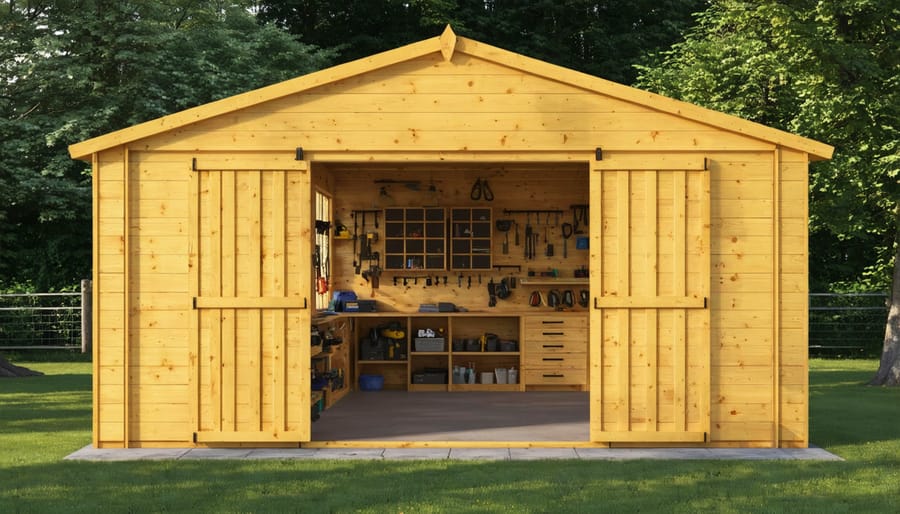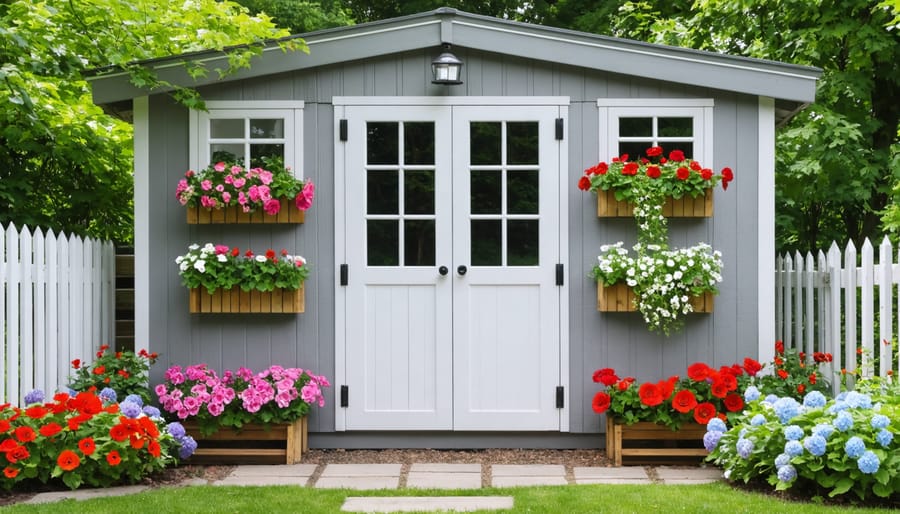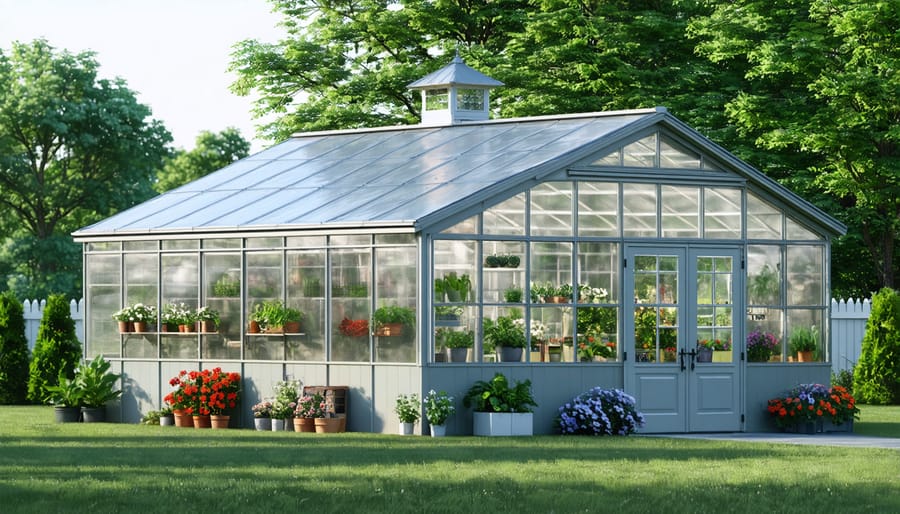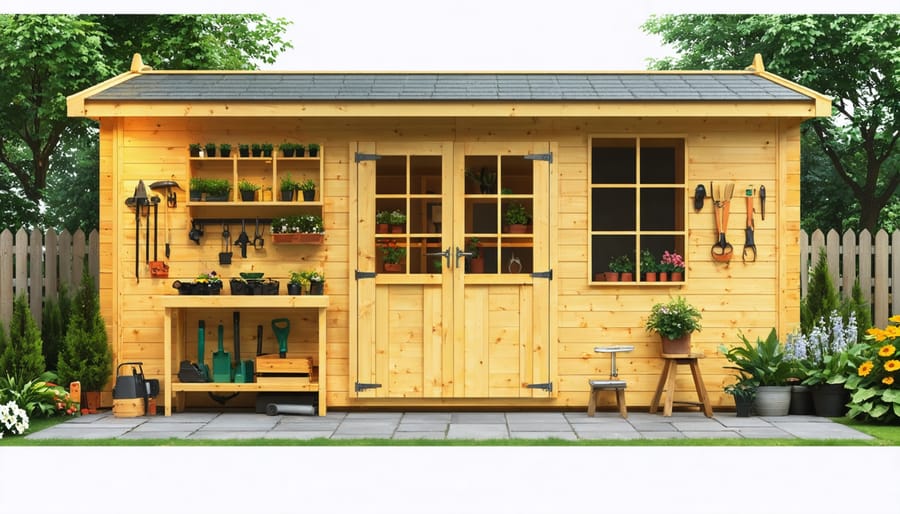Transform your outdoor space with the perfect wooden shed – a decision that goes far beyond simple storage. From charming potting sheds that double as garden workspaces to robust workshop sheds built for serious DIY projects, wooden sheds offer unmatched versatility and natural beauty. Modern wooden sheds come in various architectural styles, including classic gable, space-saving lean-to, and elegant saltbox designs, each serving distinct purposes and complementing different home aesthetics.
When selecting from these diverse wooden shed types, consider three key factors: intended use (storage, workshop, or multi-purpose), available space, and local climate conditions. Traditional timber construction provides superior durability and natural insulation, while contemporary pressure-treated woods offer enhanced weather resistance and reduced maintenance requirements.
Whether you’re protecting garden tools, creating a dedicated workspace, or establishing a backyard retreat, understanding the distinct characteristics of each wooden shed type ensures you’ll make an investment that serves your needs for years to come.
Traditional Workshop Sheds
Design Features
Modern wooden sheds offer a range of practical design features that enhance their functionality and comfort. A well-designed workbench is essential for DIY projects and repairs, ideally positioned near windows for natural light. Smart tool storage solutions, including pegboards, wall-mounted racks, and adjustable shelving systems, help keep everything organized and easily accessible.
Proper ventilation is crucial for maintaining a comfortable workspace and protecting stored items from moisture damage. Most quality sheds incorporate roof vents, adjustable windows, and soffit vents to ensure adequate air circulation. For year-round comfort, consider insulating your workshop shed to regulate temperature and reduce humidity.
Storage solutions can include overhead rafters for long items like lumber, built-in cabinets for power tools, and corner shelving units for maximizing space efficiency. Many modern sheds feature electrical outlets for power tools and lighting, while strategic window placement provides natural illumination during daylight hours.
Security features such as reinforced door frames, heavy-duty hinges, and quality locks protect your valuable tools and equipment. Some designs include covered outdoor storage areas or small porches, offering additional workspace and protection from the elements.

Best Uses
Workshop sheds are incredibly versatile spaces that can transform your DIY projects and hobbies into organized, productive activities. These dedicated workspaces are perfect for woodworking enthusiasts who need room for power tools, workbenches, and material storage. With proper ventilation and lighting, they provide an ideal environment for detailed tasks like furniture restoration or model building.
Many homeowners use their workshop sheds as creative studios, setting up easels for painting or pottery wheels for ceramics. The separate space helps contain mess and noise while providing a peaceful retreat for focusing on your craft. Automotive enthusiasts often convert these sheds into maintenance areas for small engine repair or bicycle maintenance.
For gardening enthusiasts, workshop sheds serve as excellent potting stations and tool storage areas. You can install shelving for organizing seeds, pots, and supplies, while a sturdy workbench provides space for transplanting and maintaining garden equipment.
These sheds also make great spaces for seasonal projects, like holiday decoration storage and crafting. With proper insulation and climate control, you can use your workshop year-round, making it a valuable addition to any property. Many homeowners even incorporate small office spaces within their workshop sheds, creating a multi-purpose area that combines productivity with hobby work.

Cottage-Style Garden Sheds
Architectural Elements
Architectural elements can transform a basic wooden shed into a charming backyard feature that complements your home’s style. Window boxes add a welcoming touch while providing opportunities for seasonal flowers or herbs. These simple additions not only enhance curb appeal but also create a more integrated look with your garden landscape.
Decorative trim, including gable ornaments, corner boards, and fascia details, can elevate your shed’s appearance significantly. Consider adding shutters beside windows or installing crown molding along the roofline for a more polished look. These elements work together to create visual interest and character.
Dutch doors offer both practical functionality and rustic charm. Split horizontally, they allow you to open the top half for ventilation while keeping the bottom closed – perfect for keeping pets out while working inside. This feature is particularly useful in garden sheds where you might want to monitor temperature and airflow.
Other architectural touches worth considering include cupolas for improved ventilation, weathervanes for decorative flair, and traditional barn-style door hardware. Even simple additions like window grids or a covered entryway can dramatically enhance your shed’s overall appearance while maintaining its practical purpose.
Practical Applications
Wooden sheds offer remarkable versatility, seamlessly blending practical storage with aesthetic appeal in your outdoor space. A well-chosen shed can serve as both a functional storage solution and an attractive garden focal point. Many homeowners use their sheds as potting stations, combining tool storage with a dedicated workspace for gardening projects. Before installation, ensure you select the best foundation for your shed to maximize its longevity and functionality.
Consider creating a charming garden vignette by surrounding your shed with climbing plants or decorative containers. This approach transforms a simple storage structure into an enchanting garden feature. The natural warmth of wood makes it ideal for this dual-purpose role, as it can be painted or stained to complement your home’s exterior while maintaining its primary storage function.
Many homeowners successfully use their wooden sheds as multi-purpose spaces: storing seasonal decorations and garden equipment in one section while utilizing another area as a potting bench or DIY workspace. Some even incorporate built-in shelving and pegboards to maximize vertical storage while maintaining an organized, attractive appearance that enhances rather than detracts from their garden’s overall design.
Lean-To Storage Sheds
Space-Saving Benefits
When space is at a premium in your backyard, a lean-to shed design can be your best friend. These clever structures make the most of limited area by attaching directly to an existing wall of your home or garage, eliminating the need for a standalone building. This smart design choice can save up to 25% of the footprint compared to traditional shed styles.
The vertical space optimization in lean-to sheds is particularly impressive. With their sloped roof design, these sheds can accommodate tall items like ladders and garden tools along the higher wall while storing smaller items near the lower end. Many homeowners find that this natural organization system helps them maximize their storage efficiency.
Another space-saving advantage is the ability to position these sheds in otherwise unused areas, such as narrow side passages or awkward corners. The single-slope roof also means rainwater runs off in one direction, making it easier to collect for garden use or direct away from your property. This practical design is especially popular in urban areas and townhouse communities where yard space comes at a premium.
Installation Considerations
Before installing your wooden shed, proper site preparation is essential for longevity and stability. Start by choosing a level spot that’s well-drained and away from water-collecting areas. If you’re placing the shed against your house, ensure it’s at least 6 inches below any siding to prevent moisture damage.
A solid foundation is crucial – consider concrete blocks, gravel beds, or a concrete slab depending on your local climate and terrain. Leave at least 2 feet of clearance around the shed for maintenance and proper airflow, and check local building codes for setback requirements from property lines.
Consider sunlight exposure and accessibility when positioning your shed. While natural light is beneficial, excessive direct sunlight can fade and damage wood over time. Think about how you’ll move items in and out – ensure pathways are clear and the door placement makes sense for your needs.
Don’t forget overhead clearance – check for low-hanging branches or power lines that could interfere with construction or pose safety hazards. If you live in a windy area, position the shed to minimize exposure to prevailing winds.
Multi-Purpose Garden Buildings
Combination Designs
For homeowners seeking versatile storage solutions, combination designs offer the best of both worlds. The most popular hybrid option is wood greenhouse combinations, which feature a traditional storage area alongside a light-filled growing space. These innovative designs typically include clear panels or windows on one side while maintaining solid wooden walls on the other.
Other creative combinations include shed-workshop hybrids, which incorporate a dedicated workspace with proper ventilation and natural light, alongside traditional storage areas. Some designs feature a covered porch or extended roof area, creating a protected outdoor workspace or relaxation spot.
Popular among gardening enthusiasts are potting shed combinations, which include built-in workbenches, specialized storage for tools, and optimal lighting for plant care. These designs often feature strategic window placement to maximize natural light while maintaining privacy and security for stored items.
For those with limited space, multi-purpose combinations can include cleverly designed storage walls, fold-down workbenches, and modular shelving systems that adapt to changing needs throughout the seasons.

Customization Options
One of the best features of wooden sheds is their adaptability to your specific needs. Start by adding shelving units and pegboards to maximize vertical storage space – perfect for organizing garden tools and equipment. Installing workbenches along the walls can transform your shed into a functional workshop, while adding windows increases natural light and improves ventilation.
Consider adding electrical outlets if you plan to use power tools or need lighting for evening work. Partition walls can create separate zones for different activities, such as a potting area and tool storage. Custom door options, like double doors or sliding barn doors, can improve access and make moving large items easier.
For enhanced security, consider adding reinforced locks, window bars, or motion-sensor lights. Weather protection can be improved with additional roof overhangs or covered porches, which also create useful outdoor workspace. Interior wall panels can provide extra insulation and a cleaner look, while custom exterior trim and paint colors help match your home’s aesthetic.
Don’t forget practical additions like roof vents for better air circulation, built-in storage solutions, and even fold-down tables to save space. These customizations help ensure your shed serves its intended purpose while maintaining its charm and functionality.
Wood Types and Maintenance
Best Woods for Durability
When it comes to building a long-lasting shed, choosing the right wood type is crucial. Cedar stands out as a top performer, naturally resistant to rot, decay, and insect infestations. While it comes at a premium price point, its natural oils provide excellent weather protection and a distinctive, pleasant aroma.
Pressure-treated pine offers an excellent balance of durability and affordability. Treated with special preservatives, it resists moisture damage and insect attacks, making it particularly suitable for ground contact and humid environments. Though not as naturally resistant as cedar, it can last 20+ years with proper maintenance.
Douglas fir is another sturdy option, known for its strength and stability. It holds up well against heavy loads and resists warping, making it ideal for structural components like floor joists and wall frames. While it requires protective treatment for outdoor use, its natural strength makes it worth considering.
For budget-conscious builders, pine is a practical choice. Though less naturally durable than cedar or Douglas fir, when properly treated and maintained, it can provide years of reliable service. Regular sealing and painting will significantly extend its lifespan and protect it from the elements.
Remember, regardless of wood type, proper installation and regular maintenance are key to maximizing durability.
Preservation Tips
To maximize your wooden shed’s lifespan, regular maintenance is essential. Start by inspecting your shed twice yearly for signs of wear, damage, or pest infestation. Pay special attention to waterproofing wooden structures, as moisture is your shed’s biggest enemy.
Apply a quality wood preservative or stain every 2-3 years to protect against UV damage and moisture. Focus on treating the base of the shed, corners, and areas around windows and doors where water tends to collect. Keep gutters clean and ensure proper drainage around the structure to prevent water pooling.
Maintain good ventilation by keeping vents clear and doors occasionally open during dry weather. This helps prevent mold and mildew growth. Trim back any overhanging branches or vegetation that could trap moisture against the shed walls.
Check and tighten any loose hardware regularly, including hinges, locks, and roof fasteners. Address small repairs promptly before they become major issues. A quick response to minor damage can prevent costly repairs later.
Consider applying weather stripping around doors and windows to keep out drafts and moisture. During winter months, remove heavy snow from the roof to prevent structural stress.
Choosing the right wooden shed for your property is an important decision that can enhance both your storage capabilities and your home’s overall appeal. Whether you’re looking for a compact tool shed, a spacious workshop, or something in between, there’s a wooden shed design that perfectly matches your needs. Remember to consider factors like available space, intended use, local climate, and building regulations before making your final decision.
The key is to balance functionality with aesthetics while staying within your budget. Consider features like windows for natural light, proper ventilation, and door placement to ensure your shed serves you well for years to come. Don’t forget to factor in maintenance requirements and treat your wooden shed appropriately to protect it from weather damage and extend its lifespan.
Take time to research different styles, compare materials, and possibly visit local display centers to see various options in person. By making an informed choice based on your specific requirements, you’ll invest in a wooden shed that not only meets your storage needs but also adds value to your property for years to come.





Leave a Reply